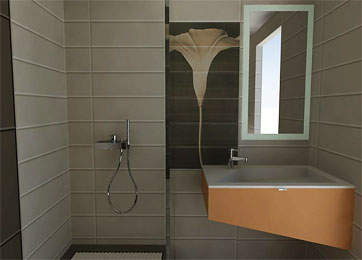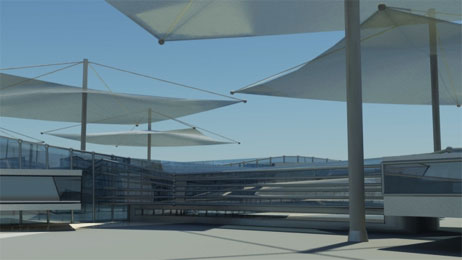Learn AutoCAD with our Free Tutorials
Welcome to CADTutor
CADTutor provides the best free tutorials and articles for AutoCAD, 3ds Max and associated applications along with a friendly community forum. If you need to learn AutoCAD, or you want to be more productive, you're in the right place. See our tip of the day to start learning right now!
Free Tutorials and More…
The Tutorials section provides over 100 original tutorials for AutoCAD, 3ds Max and other design applications. Michael’s Corner is an archive of productivity articles that brings you the best AutoCAD tips and tricks. Our Forum is a lively community where AutoCAD users can ask questions and get answers. The Downloads area provides free AutoCAD blocks, free AutoLISP routines and free images.
Tutorials of the Moment
Recently viewed tutorials
-
Ground Modelling

This tutorial describes how to create a 3D surface model from contour information using AutoCAD and Key TERRA-FIRMA. Format: Text/Image
Last visited: less than one minute ago
-
Setting up a PostScript Plotter

How to set up a PostScript Plotter. Format: Text/Image
Last visited: less than one minute ago
-
AutoLISP Quick Start

This tutorial is designed to help AutoCAD users get to grips with AutoLISP quickly. It demonstartes how to create AutoLISP routines from a standing start. Format: Text/Image
Last visited: less than one minute ago
-
Dimensioning

This tutorial describes the options and commands available for dimensioning drawings and how to use them. The correct use of AutoCADs dimension tools is the key to producing clear and concise measured drawings. Format: Text/Image
Last visited: 1 minute ago
-
Converting Audio CD tracks to MP3 Files

This tutorial explains how to rip CD tracks to MP3 files, ready for playing within a PowerPoint slide show. Format: Text/Image
Last visited: 2 minutes ago
-
Entering Survey Data using AutoCAD

These techniques apply to basic CAD programs such as AutoCAD, IntelliCAD, etc. If you have a civil/survey program or add-on, such as Land Desktop, SurvCADD, Eagle Point, etc., then there are built-in tools for entering lines and curves. Format: Text/Image
Last visited: 2 minutes ago
CADTutor Tutorials
Our tutorials are comprehensive but straightforward introductions to AutoCAD and related software. They are designed to help beginners get to grips with design workflows as quickly as possible. There are over 100 to choose from, some text/image based and others in video format. Whatever stage you are at in your learning, you should find a tutorial to help.
Forum Latest
Currently Active Topics
Help Appreciated: Force Existing Layer Names to UPPER CASE Not Working
by Clint
26 replies
Last post: 9 hours ago
updating an exploded material table
by Mahdi_Nasr
7 replies
Last post: 11 hours ago
Lisp exportar todas las presentaciones
by mikarts
7 replies
Last post: 28 hours ago
Hybrid parallel
by PGia
127 replies
Last post: 37 hours ago
Seeking the UNMI.LSP routine (original source unavailable)
by p7q
3 replies
Last post: 43 hours ago
Display ERROR with the model space
by Gabzie_20
1 reply
Last post: 43 hours ago
This Week's Hot Topics
Create a stable true rectangle
by Nikon
13 replies
Viewed: 529 times
Can I read and copy Dynamic Block properties to another block reference?
by p7q
5 replies
Viewed: 395 times
Change MText Width (after width has been changed))
by ILoveMadoka
4 replies
Viewed: 323 times
Cursor color
by CharlieDFW
4 replies
Viewed: 299 times
XREF PATH - COPY TO CLIPBOARD
by james9710
4 replies
Viewed: 289 times
problem with initget1
by shokoufeh
4 replies
Viewed: 225 times
CADTutor Forums
Our forum is a vibrant community of experts and beginners. The main focus is helping beginners get to grips with AutoCAD and to help more advanced users become more productive. The AutoLISP forum is one of the busiest out there, providing expert advice for busy professionals.
AutoCAD Productivity
Avoid Using ‘Standard’ in Text & Dimension Styles
From: AutoCAD Productivity Articles #141
Originally published: August 2015
In addition to Layer 0, every single drawing on the planet has a Text style called ‘Standard’, and a Dimension style called ‘Standard’. They're the defaults.
When developing company standards, it's best to not modify the Standard styles; leave 'em alone and make your own.
And here's why. Let's say you have text you added to Drawing A (using your modified ‘Standard’ text style to use the Trebuchet font), and you drag that text into Drawing B where the Standard text style uses the TXT.SHX font.
Since Drawing B already has a ‘Standard’ text style—see opening sentence, above—who do you think will "win" when it comes to how the text looks? The text in Drawing B will use the font which is already assigned to the Standard text style.

In the illustration, you see the result when I drag the text from Drawing A into Drawing B. Questions?
See all the articles published in August 2015
Michael's Corner
Between 2003 and 2016, Michael Beall (and one or two guests) wrote almost 600 articles for CADTutor. The focus of these articles is AutoCAD productivity, and although some of them are now more than a few years old, most remain relevant to current versions of AutoCAD. The article above is just one example. Check out Michael's Corner for a full listing.
Image of the Week
-
8th – 14th December 2025

This week's image is by Dorian
Software used: AutoCAD 2008
-
Last Week's Image

Last week's image is by mehiar
Software used: 3ds Max
-
Two Weeks Ago

This image is by Titi95
Software used: AutoCAD 2014
-
Three Weeks Ago

This image is by Titi95
Software used: AutoCAD 2015 and Keyshot
Gallery of Work
Over the years, our forum members have contributed hundreds of images, showcasing their amazing work. The images above are just a small selection that demonstrate the wide range of project types our community is involved with. Take a look at our gallery to see all the images published in the last 12 months.
Tip of the Day
DWG TrueView
![]() Quite often, you need to share your AutoCAD drawings with co-workers or others who don't have a copy of AutoCAD. In the past, this meant either providing drawings in DWF or buying some special viewing software. Well, now you can share your drawings files in DWG format for free.
Quite often, you need to share your AutoCAD drawings with co-workers or others who don't have a copy of AutoCAD. In the past, this meant either providing drawings in DWF or buying some special viewing software. Well, now you can share your drawings files in DWG format for free.
Autodesk's own DWG TrueView application is free to download and install, and it looks just like AutoCAD. Co-workers without AutoCAD can not only view your drawings but they can plot them too and publish them as DWF. See here for more information.
Missed a Tip?
Did you miss yesterday's tip? Maybe you forgot to drop by or maybe you don't visit over the weekend. If so, you can now see all the tips published during the past week. Also, if you have a tip you'd like to share with us, you can post it on our forum and if we like it, we'll publish it here.